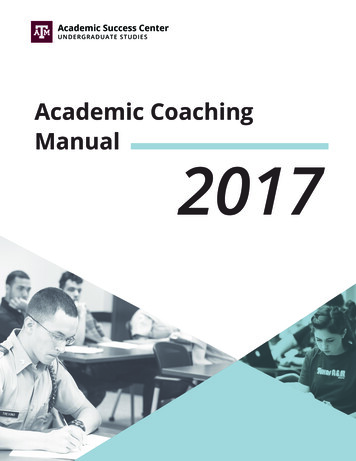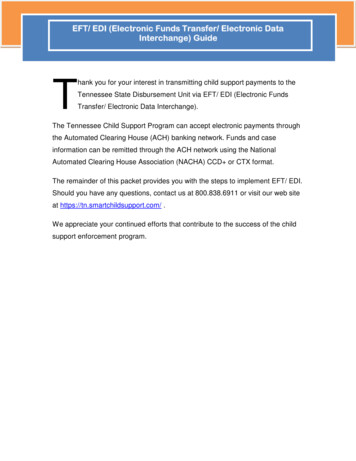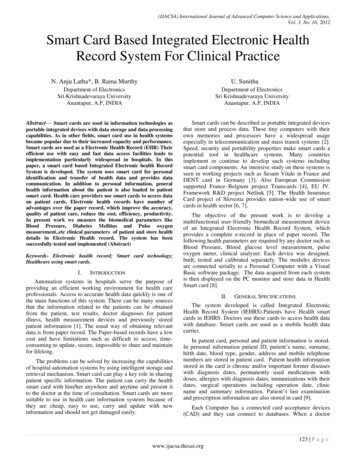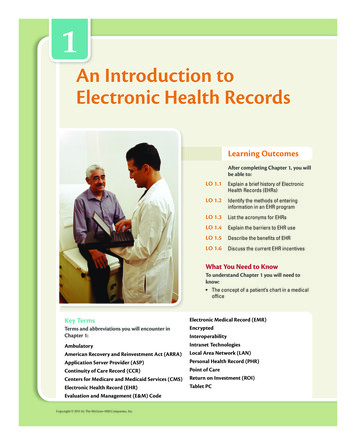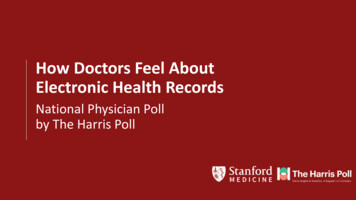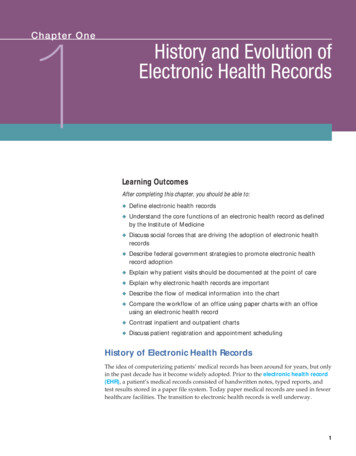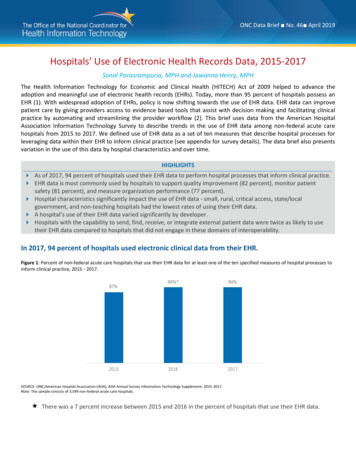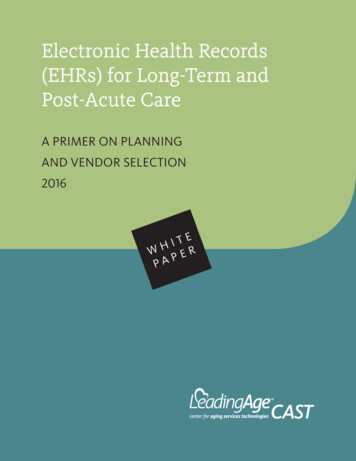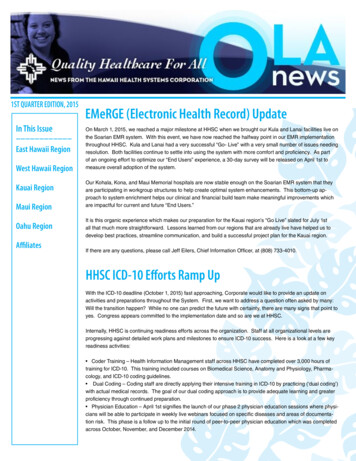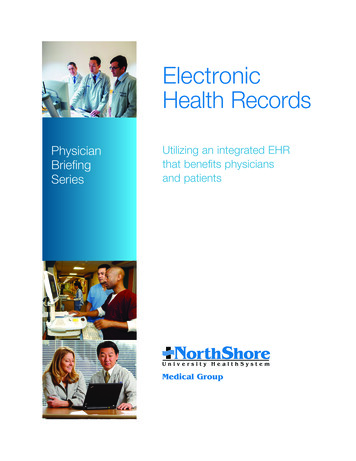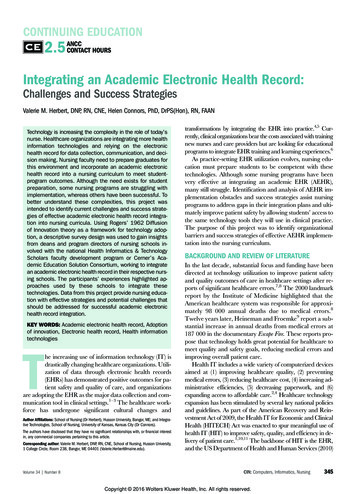
Transcription
CONTINUING EDUCATION2.5 ANCCCONTACT HOURSIntegrating an Academic Electronic Health Record:Challenges and Success StrategiesValerie M. Herbert, DNP, RN, CNE, Helen Connors, PhD, DrPS(Hon), RN, FAANTechnology is increasing the complexity in the role of today’snurse. Healthcare organizations are integrating more healthinformation technologies and relying on the electronichealth record for data collection, communication, and decision making. Nursing faculty need to prepare graduates forthis environment and incorporate an academic electronichealth record into a nursing curriculum to meet studentprogram outcomes. Although the need exists for studentpreparation, some nursing programs are struggling withimplementation, whereas others have been successful. Tobetter understand these complexities, this project wasintended to identify current challenges and success strategies of effective academic electronic health record integration into nursing curricula. Using Rogers’ 1962 Diffusionof Innovation theory as a framework for technology adoption, a descriptive survey design was used to gain insightsfrom deans and program directors of nursing schools involved with the national Health Informatics & TechnologyScholars faculty development program or Cerner’s Academic Education Solution Consortium, working to integratean academic electronic health record in their respective nursing schools. The participants’ experiences highlighted approaches used by these schools to integrate thesetechnologies. Data from this project provide nursing education with effective strategies and potential challenges thatshould be addressed for successful academic electronichealth record integration.KEY WORDS: Academic electronic health record, Adoptionof innovation, Electronic health record, Health informationtechnologieshe increasing use of information technology (IT) isdrastically changing healthcare organizations. Utilization of data through electronic health records(EHRs) has demonstrated positive outcomes for patient safety and quality of care, and organizationsare adopting the EHR as the major data collection and communication tool in clinical settings.1–3 The healthcare workforce has undergone significant cultural changes andTAuthor Affiliations: School of Nursing (Dr Herbert), Husson University, Bangor, ME; and Integrative Technologies, School of Nursing, University of Kansas, Kansas City (Dr Connors).The authors have disclosed that they have no significant relationships with, or financial interestin, any commercial companies pertaining to this article.Corresponding author: Valerie M. Herbert, DNP, RN, CNE, School of Nursing, Husson University,1 College Circle, Room 238, Bangor, ME 04401 (Valerie.Herbert@maine.edu).Volume 34 Number 8transformations by integrating the EHR into practice.4,5 Currently, clinical organizations bear the costs associated with trainingnew nurses and care providers but are looking for educationalprograms to integrate EHR training and learning experiences.6As practice-setting EHR utilization evolves, nursing education must prepare students to be competent with thesetechnologies. Although some nursing programs have beenvery effective at integrating an academic EHR (AEHR),many still struggle. Identification and analysis of AEHR implementation obstacles and success strategies assist nursingprograms to address gaps in their integration plans and ultimately improve patient safety by allowing students’ access tothe same technology tools they will use in clinical practice.The purpose of this project was to identify organizationalbarriers and success strategies of effective AEHR implementation into the nursing curriculum.BACKGROUND AND REVIEW OF LITERATUREIn the last decade, substantial focus and funding have beendirected at technology utilization to improve patient safetyand quality outcomes of care in healthcare settings after reports of significant healthcare errors.7,8 The 2000 landmarkreport by the Institute of Medicine highlighted that theAmerican healthcare system was responsible for approximately 98 000 annual deaths due to medical errors.8Twelve years later, Heineman and Froemke9 report a substantial increase in annual deaths from medical errors at187 000 in the documentary Escape Fire. These reports propose that technology holds great potential for healthcare tomeet quality and safety goals, reducing medical errors andimproving overall patient care.Health IT includes a wide variety of computerized devicesaimed at (1) improving healthcare quality, (2) preventingmedical errors, (3) reducing healthcare cost, (4) increasing administrative efficiencies, (5) decreasing paperwork, and (6)expanding access to affordable care.2,4 Healthcare technologyexpansion has been stimulated by several key national policiesand guidelines. As part of the American Recovery and Reinvestment Act of 2009, the Health IT for Economic and ClinicalHealth (HITECH) Act was enacted to spur meaningful use ofhealth IT (HIT) to improve safety, quality, and efficiency in delivery of patient care.1,10,11 The backbone of HIT is the EHR,and the US Department of Health and Human Services (2010)CIN: Computers, Informatics, NursingCopyright 2016 Wolters Kluwer Health, Inc. All rights reserved.345
CONTINUING EDUCATIONhas dedicated significant resources toward EHR adoption byhospitals and eligible providers.12To attain federally mandated “meaningful use” of technology, healthcare organizations are purchasing and adoptingEHRs. Introduction of the EHR into clinical workflows has created numerous changes in nursing practice, requiring significant training in systems operations, effective data entry, andutilization of information for practice decisions.13,14 Healthcareemployers are now looking for educational programs to includeIT and EHR experiences as part of the program of study.6,15Nursing Education and Electronic Health RecordsWith clinical settings integrating more HIT and relying onthe EHR for data collection, communication, and decisionmaking, nursing faculty need to prepare graduates with theknowledge and skills for EHR utilization. As these technologies become part of healthcare workflow, nurses’ roles haveexpanded to include HIT competencies to ensure organizational compliance in “meaningful use.”16 The literaturehighlights the need to prepare nursing students within educational settings to facilitate development of the technologyknowledge and skills that ultimately improves patient care.17,18To address nursing graduate competencies with IT, accreditation bodies and national educational initiativesare driving the changes needed in nursing programs. TheNational League for Nursing Accrediting Commission andthe Commission on Collegiate Nursing Education currentlyhave program standards that include technology and informatics to meet healthcare needs and expectations.19,20 Theseaccreditation organizations recognize the essential need fornurses to have skills and abilities in information managementto function in today’s healthcare system.Program and Faculty DevelopmentBeyond program standards, substantial efforts have been established to support nursing programs and faculty development in adopting information technologies.18,21–23 In 2005,the Quality and Safety Education for Nurses (QSEN) projectbegan with funding from the Robert Wood Johnson Foundation to meet the challenges of preparing future nurses toimprove patient safety and the quality of care.24 The QSENframework identifies six competency areas for nursing programs: (1) patient-centered care, (2) teamwork and collaboration, (3) evidence-based practice, (4) quality improvement,(5) safety, and (6) informatics. Although the informatics competencies specifically highlight the need for EHR access, theEHR technology can be used to support all six domains ofthe QSEN competencies.In 2006, more than 100 nursing leaders from administration, practice, education, informatics, and governmentalagencies gathered at the Technology Informatics GuidingEducation Reform Summit (TIGER) and shared a vision346for crossing the quality chasm with IT. The vision outlinedseven pillars of critical components as a framework transforming the nursing profession, using timelines and actionplans. The TIGER initiative identified essential nursingtechnology skills needed for the 21st-century practice.21,23To support faculty development, in 2008 the HealthInformatics and Technology Scholars (HITS) program wasdeveloped through a collaborative partnership with fournursing programs and the National League for Nursing.25Supported by a Health Resources and Service Administration (HRSA) grant, the 5-year program provided a yearlongintensive and immersive experience for faculty in the use andapplication of HIT, culminating in each participating scholardeveloping a program-based project for their institution.National nursing efforts have identified a vision, created a framework and competencies, and included facultydevelopment to implement information technologies. Yeteven with these national programs and initiatives, manynursing schools have not fully utilized the EHR and lack fullintegration of information technologies into the curriculum.26–28 Although overall goals of patient safety and improved care remain the global focus of both clinical andacademic areas, nursing education programs have uniquechallenges and barriers that affect EHR integration.29Preparing nursing students for the complexity of today’stechnology-rich healthcare setting requires relevant learningopportunities. Nursing faculty need to “prepare nurses to beable to access and synthesize knowledge, integrate evidenceinto practice, work collaboratively and in interdisciplinaryteams, use clinical information and decision support systems,and provide safe and ethical care.”30(p9) Often nursing faculty still lack the knowledge and skills to effectively adoptan AEHR and integrate into the curriculum.31 Several national initiatives have been directed toward these learninggaps, but often strategies fail to address faculty buy-in anddevelopment needs.32 Evidence indicates nursing facultycan be a significant barrier to implementing EHR technologies.33,34 Attention to faculty development should be a cornerstone of any strategic plan for AEHR implementation.Electronic Health Record AccessAccess to an EHR can be a major barrier for some nursingprograms in addressing informatics and technology competencies. To attain progressive competency with EHRtechnologies, nursing students need multiple opportunities tointeract with the EHR that mimics the reality in healthcare.3,18Nursing programs are using different approaches to addressthe EHR access issue.One approach is for nursing schools to partner with clinical organizations for student access during clinical rotations.15,35 To ensure patient confidentiality and dataaccuracy, students are required to participate in EHRCIN: Computers, Informatics, NursingCopyright 2016 Wolters Kluwer Health, Inc. All rights reserved.August 2016
training, placing a significant financial burden on healthcareorganizations. The mandatory training is also a significantcommitment for students and takes away from valuable clinical time. Once student-level training is complete, nursingstudents can then use the institutional EHR to researchassigned patients and document on assigned patient care under the supervision of clinical faculty. Access is generally restricted to on-site because of patient confidentiality andsecurity restrictions, preventing nursing faculty from expanding teaching strategies and using the EHR duringclassroom or laboratory experiences that can build uponcompetencies.Because of limitations of the clinical EHR to meet complex student learning needs, some organizations have developed or purchased an AEHR. The AEHR is a system thatmirrors real life and allows faculty to create a variety ofteaching experiences within the AEHR.36 The usability features of an AEHR contain the major components of a trueEHR, providing “students with learning opportunities thatdevelop competencies in patient assessment, clinical knowledge, decision making, and documentation.”37(pp133–137)Much like simulation, the AEHR can be utilized to addresscritical thinking in a safe environment without concern ofharming actual patients.38 For some nursing programs, thefiscal resources to purchase the AEHR may be cost prohibitive. Many full-featured products require expensive leases orshift significant cost onto students through fees.36An access alternative for some schools has been to developtheir own AEHR, but this has limits as well. Designing a fullfeatured EHR capable of allowing students to enter andretrieve data, track performance, and achieve successful informatics capabilities requires substantial time and expertise.39For schools to create their own AEHR requires significant organizational investment in technology development and support resources and may be too demanding for programs.Some nursing programs are entering into partnershipswith clinical settings to gain access to the training EHR beyond the clinical rotation to promote student learning opportunities.15,35 With the cost of orienting newly hired nurses andother healthcare professionals to an organization’s EHR system, practice settings are recognizing the benefits of expandedlearning for nursing students.15 Unfortunately, all nursingprograms do not have partnerships with healthcare organizations for access to the EHR beyond the clinical setting.FrameworkThis study used Rogers’40 1962 Diffusion of Innovation theory as a framework for assessing faculty adoption and diffusion of the AEHR within nursing programs. The theory isutilized to guide the development of concepts and relationships whereby adoption refers to an individual process of decision making, and diffusion is the actual spread of the ideaVolume 34 Number 8to others. To effectively diffuse the AEHR within a nursingprogram, the study considers both the level of individualAEHR adoption and the diffusion process needed for the organization. Diffusion of Innovation theory has been used as aframework in multiple studies and across different disciplines,including “medical sociology, communication, marketing, developmental studies, health promotion, organizational studies,knowledge management, and complexity studies,”41(p418) andmore recently with technology and healthcare records.42,43In 1995, Rogers44 identified five progressive stages in theadoption of an innovation: (1) knowledge, (2) persuasion, (3)decision, (4) implementation, and (5) confirmation. Rogers’theory identifies adoption as an individual or group processof decision making, and at crucial steps, the advantagesand disadvantages are weighted to determine whether to reject or accept the innovation. If the innovation is accepted,the process will move forward to the next stage of adoption.Individuals or groups first gain knowledge or informationabout the innovation and if interested are persuaded to seekout more information. If innovation is viewed as valuablethen a decision is made to implement on a small scale. Finally, the innovation moves to confirmation when fully integrated or utilized by the individual or group.44Diffusion is the actual spread of the idea from one individual to others within the social system and consists of four elements that affect the actual dissemination of the idea: (1) theinnovation, (2) communication channels, (3) time, and (4) thesocial system.45 The interaction of these elements determinesthe length of time for diffusion, defined as the process inwhich an idea moves through communication channels overtime among individuals within the social system.40 Depending on the rate of adoption, Rogers’40 1962 Diffusion ofInnovation theory classifies individuals or groups into fivecategories: (1) innovators, (2) early adopters, (3) early majority, (4) late majority, and (5) laggards.40 The Diffusion ofInnovation theory in 1995 clarifies the necessary steps foraccepting novel ideas, characteristics of the innovation thatinfluence adoption, actual process used to reach adoptionor rejection of any innovation, and established categoriesbased on rate of adoption.44METHODSStatement of the ProblemA significant need exists for an EHR in the academic settingto provide students with active teaching-learning opportunities that promote integration of technology with practice. Although the literature indicates the need for studentpreparation, some nursing programs are struggling toachieve implementation, whereas others have been quitesuccessful. The complexities of implementing an AEHR intoa nursing curriculum must be considered to meet the ultimate goal of providing safe and effective care for patients.CIN: Computers, Informatics, NursingCopyright 2016 Wolters Kluwer Health, Inc. All rights reserved.347
CONTINUING EDUCATIONPurpose of the StudyThe purpose of this project was to identify organizational approaches that were success strategies or barriers to implementation of the AEHR. The importance of identifyingsuccessful strategies and potential barriers provides nursingprograms with essential information needed to implementand sustain integration of AEHR technologies vital for educating today’s nursing students.Research Questions1. In the adoption of the AEHR as a teaching strategy innursing education, what is the perceived level of adoption by participant’s organization?2. What are the success strategies to accessing and implementing an AEHR in a nursing program?3. What are the barriers to accessing and implementingan AEHR in a nursing program?ConsentHuman subject rights were protected by obtaining approvalfrom the University of Kansas Human Subjects Committeeprior to beginning. An informational letter was sent toall participants via e-mail and included details regarding implied consent upon completion of the online survey, a detailedexplanation of consent procedures, and contact informationfor any questions. Also included in the information letterwas a detailed explanation of participant’s rights, including:information regarding participant’s right to confidentiality ofinformation gained in the survey, use of assigned numbersfor data collection, and right to refuse to participate or withdraw at any time without penalties.SampleThe study utilized a nonprobability convenience sample ofdeans, program directors, and chairpersons or their designeesof nursing schools within the United States involved with thenational HITS program from 2008 to 2012, or Cerner’sAcademic Education Solution (AES) Consortium. Specifically,the participant sample had projects involving the use of anEHR in their nursing programs. The HITS program is afaculty development program supporting the integration ofinformatics and other technologies into nursing educationsupported by an HRSA grant awarded to the University ofKansas School of Nursing. The HITS program is in collaboration with University of Colorado Denver, Johns HopkinsUniversity, Indiana University, and the National Leaguefor Nursing.25The AES Consortium is a group of members utilizingCerner’s AES product, an AEHR for teaching and learningin health professional programs. The consortium membersare from universities and schools using the AES as an educational strategy.46 The consortium consists of users from348healthcare programs including nursing, medicine, healthinformation management, occupational health and physicaltherapy, and pharmacy.47Inclusion criteria for the study were deans, program directors, chairpersons, or their designees; from schools participating in the HIT scholar's program from 2008 to 2012who have projects involving EHRs and/or simulated healthrecords in nursing, or from schools active with AES Consortium; and willingness to complete the survey questionnaire.Exclusion criteria for the study included potential participants as listed previously not associated with a nursing program involved in using an AEHR.Survey InstrumentDat
sion making. Nursing faculty need to prepare graduates for this environment and incorporate an academic electronic health record into a nursing curriculum to meet student-program outcomes. Although the need exists for student preparation, some nursing programs are struggling with implementation, whereas others have been successful. To

